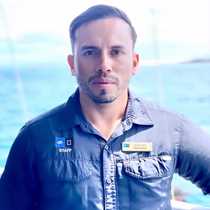Chinese Hat & Sullivan Bay (Santiago Island)
The garua season welcomed us this morning with some cold breeze and gray skies, but that did not stop us from going on a zodiac ride along the young lava from 1897. This was an area known as Chinese hat, where the separation of s small islet and the coast of Santiago formed a small bay with clear waters and quite some shore birds along the coast. We certainly saw many striated herons, brown pelicans and even a Galapagos Hawk, but in the water a whole world was recalled; as we looked for fauna in the water, a big manta ray was seen filter-feeding on the planktonic waters off the coast Santiago. A few Galapagos penguins were also seen fishing around the area.
Soon, we headed to explore the blue heart of the planet and we certainly saw plenty of fish together with white-tipped reef sharks, rays and penguins which appeared right in front of us when we least expected them. The ocean floor was colorful with many coral heads and some marine iguanas eating green algae off the rocky bottom. Some sharks were just resting in the underwater caves while one eagle ray we saw was feeding on the marine invertebrates found on the sandy bottom.
It couldn’t get better than this wonderful snorkeling outing at Chinese hat!
After lunch, the National Geographic Islander repositioned on the opposite side of Santiago, traveling back in time, allowing us to see the beginning of life establishing in the Galapagos. “This seems like a landscape from Mars,” a guest said. He certainly was right; the young basaltic lava had formed all kinds of geological features, with the surface of Pahoe-hoe shape and collapsed lava tubes. All the enchanted islands had to go over this process of erosion to become successfully established by living organisms. An interesting process known as first succession, was slowly happening around us.
Many colors, shapes, textures and feelings were expressed by this barren terrain. Few endemic lava cacti were just appearing as new signs of life here. We all enjoyed this hike over the very young lava flow, where only time and erosion factors will determine the existence of others who later will call this place home.




